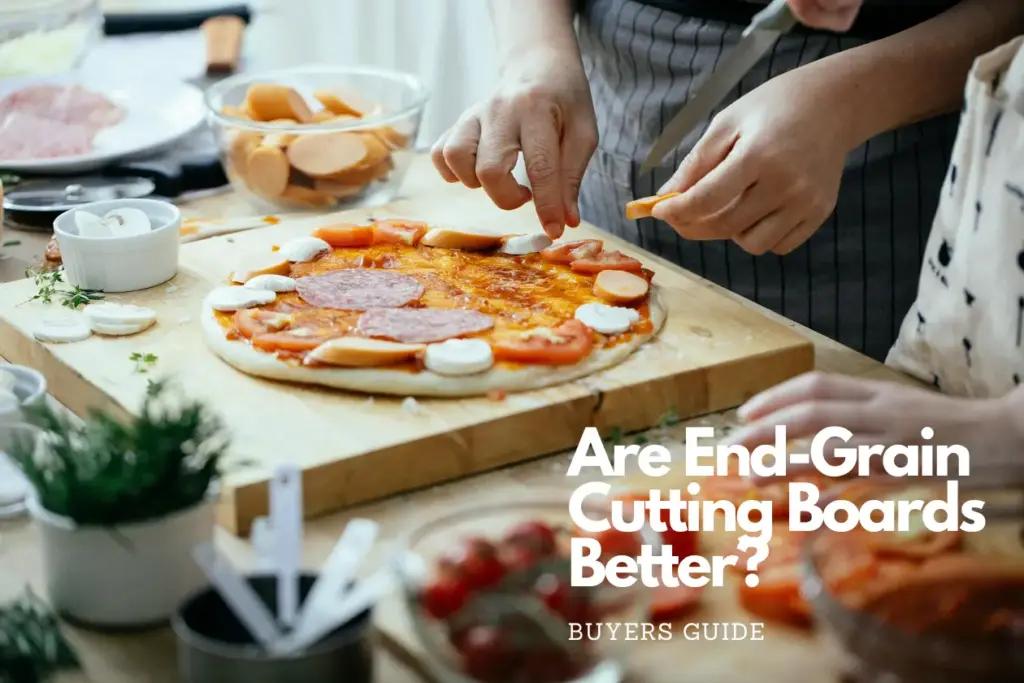Are End Grain Cutting Boards Better?
Are end grain cutting boards better? This is a question that sparks debate among professional chefs and passionate home cooks. Cutting boards may seem like a simple kitchen tool, but the choice of board impacts your knives, your food safety, and even the overall cooking experience. End grain cutting boards stand out because of their unique construction. Unlike edge grain or plastic, the fibers of the wood run vertically, allowing knives to slide between them rather than chopping straight across.
The result? A surface that’s self-healing, long-lasting, and easy on your knives. But end grain boards are also heavier, pricier, and require more maintenance which leaves some cooks wondering whether they’re truly worth the investment.
In this article, we’ll dive into seven key reasons why end grain cutting boards are often considered the best. From durability and hygiene to aesthetics and cost-efficiency, we’ll cover everything you need to make an informed decision before buying your next board.
Table of Contents
The Science Behind End Grain Cutting Boards
End grain boards are made by arranging wood blocks so the grain faces upward. Instead of slicing across hard fibers, your knife slips gently between them. This makes the board more forgiving and resistant to wear. Edge grain and plastic boards, by contrast, tend to scar deeply and retain those marks permanently.
The “self-healing” nature of end grain wood means small cuts close up on their own, leaving a smoother surface over time. This unique design is why professional chefs often insist on using them, especially in high-traffic kitchens where boards take daily abuse.
Are end grain cutting boards better for durability and Longevity?
Durability is where end grain boards truly shine. A well-made board can last decades if cared for properly. Unlike plastic boards that need replacing every few years, or cheap wooden boards that warp and crack, end grain boards absorb impact instead of resisting it.
Even after years of chopping, sanding can restore the surface, making the board look new again. This longevity makes them cost-effective in the long run, despite the higher upfront price.
See this : Fine Woodworking durability tests.
Knife Preservation
Every cook knows knives are the heart of the kitchen. Replacing or constantly sharpening them can be expensive and frustrating. End grain boards help extend their lifespan.
Because the wood fibers part under the knife instead of pushing against it, blades stay sharper longer. This reduces the need for sharpening and prevents micro-damage that shortens a knife’s life. Edge grain and glass boards, by contrast, dull knives quickly.
Hygiene & Food Safety
One of the biggest misconceptions is that plastic boards are more hygienic. In reality, USDA studies show that wood especially end grain is safer. Wood contains natural antibacterial properties that kill bacteria trapped in shallow cuts. Plastic, on the other hand, develops deep scars that harbor germs even after washing.
The “self-healing” fibers of end grain boards make it harder for bacteria to hide. As long as you clean them properly and dry them upright, they remain one of the safest kitchen surfaces.
Maintenance and Care
End grain boards do require regular maintenance. They need to be oiled monthly with mineral oil or beeswax to prevent drying and cracking. For many cooks, this upkeep feels minor compared to the benefits. Our Cutting Board Maintenance: The Complete Guide offers a complete guide on taking care of your end grain cutting boards in your kitchen.
The oiling also enhances their natural patterns, keeping them beautiful over time. Think of it like seasoning a cast-iron pan a little care yields decades of use.
Cost vs. Value
At first glance, end grain boards seem expensive, sometimes costing double or triple edge grain. But consider the value: fewer knife replacements, decades of use, and better food safety.
If you’re serious about cooking, the upfront cost becomes an investment rather than an expense. Many chefs even pass their boards down like heirlooms.
Aesthetic Appeal
Finally, let’s not ignore style. End grain cutting boards have a distinct checkerboard pattern that’s instantly recognizable. They don’t just perform well they also look stunning in any kitchen.
Whether displayed on countertops or used as serving platters for bread and cheese, they add a touch of craftsmanship and beauty to your space.
So, are end grain cutting boards better? The answer is yes for durability, knife preservation, hygiene, and style, they simply can’t be beaten. While they require maintenance and cost more, their long-term value makes them the top choice for professionals and dedicated home cooks alike.
Sign up for our newsletter to get the latest kitchen care tips from Wooden Edge Studios.
Related: Read more on this article for a complete guide to selecting the perfect wooden cutting board for your kitchen needs








